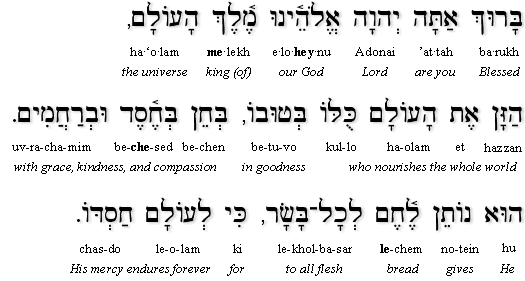
Words transliterated and translated by Gila Ansell Brauner of Jerusalem, Israel.įor all other CDs, DVDs, Books, Gifts and products click on the Jewish Australia Online ShopĬontact the publisher of Hebrew Songs. Read the text of Birkat Hamazon online with. Prayer and piyut based on Mishnah Tractate Sofrim, 20:6 Ritual order of Grace after the meal, its recitation is mandated by the Torah for someone who eats bread. View our list of Chanukah songs and dances Included in both Birkat Hamazon and daily/Shabbat Shemoneh Esrei (only Chanukah can fall on Shabbat). The body of the prayer has differentiation to specifically address Purim or Chanukah. The dance and music pertain to the first line of the special prayer recited on Purim or Chanukah. The views expressed in contributed works represent the views of their creator(s) and do not necessarily represent the views of the Open Siddur Project's developers, its diverse community of contributors, patrons, or institutional partners.In honor of the miracles and deliverance, One-time tax-deductible donations may be made through Jewish Creativity International, a 501(3)c registered non-profit organization acting as our fiscal sponsor. The Open Siddur is financially supported by recurring donations via Patreon.
BIRKAT HAMAZON TRANSLITERATION LICENSE
The default license under which all content is shared on this site is the Creative Commons Attribution/ShareAlike (CC BY-SA) 4.0 International license.Īll fonts rendered through CSS are licensed with either an SIL-Open Font License (OFL) or a GNU Public License with a Font Exception clause ( GPL+FE). Unless otherwise indicated, all creators and copyright stewards have graciously shared their work under one of the following Open Content licenses until the term of their copyright expires and their work enters the Public Domain.Ĭreative Commons Attribution/ShareAlike (CC BY-SA) 4.0 International ( עברית | English)Ĭreative Commons Attribution (CC BY) 4.0 International ( עברית | English)Ĭreative Commons Zero (CC0), a Public Domain dedication ( English) חלק מהזכויות שמורות | Some Rights Reserved.Īll works published on that are not yet in the Public Domain remain under the copyright of their respective creators and copyright stewards.
BIRKAT HAMAZON TRANSLITERATION ZIP
How mighty is Your name in all the earth!ĭownload all posts and pages: ZIP (via github)Ĭopyleft 2002-Present, Contributors to the Open Siddur Project. You have set them to govern over Your handiwork When I see Your heaven, the work of Your fingers Ī dust-born one that You account for them?Īnd You lessen them only slightly from the divine Regarding Your foes to stop enemy and avenger. O CAUSE our Master, how mighty is Your name in all the earth įrom the mouths of infants and sucklings You establish strength The literal translation here is upon the Gittite’, and the editor has here translated it into a pseudo-Italian form to reflect modern musical notation. These instructions are of unclear meaning, but probably refer to some manner of play. Note: “The CAUSE” is used to translate the Divine Name YHVH, based on the philosophical idea of God as the Prime Mover and on the interpretation of the Name as a causative form of the copula – “causes to be.”įor the conductor, gittitando Many psalms start with musical instructions.


It celebrates the variety of God’s creation as exemplified by the natural diversity of species, as well as alluding to the livestock tithes traditionally assigned on the first of Elul.

This is a poetic text for Birkat haMazon, signed with an alphabetical acrostic and the name of the author, to be recited on the first of Elul. But there is one more Rosh haShanah which is seriously underrepresented - the first of Elul, the new year for animals. The fifteenth of Shevat, also known as Tu biShvat or Khamishosor, Khamishosor is a Yiddish name for Tu biShvat. The first of Nisan is the new year for months and calculating kings’ reigns. The first of Tishri, often called Rosh haShanah, is the new year of the year count and the tithing cycles. It is relatively well known that the Hebrew calendar has four new years.


 0 kommentar(er)
0 kommentar(er)
